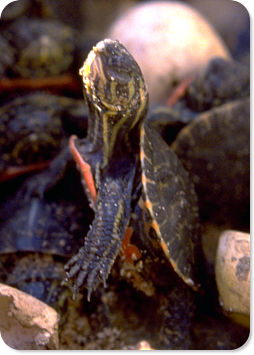 Nature has cool ways of coping below zero.(Published in the Winnipeg Free Press, Mar. 25, 2001) Boy, I got a lot of feedback about the article I did on "Frog-cicles". Cryo-preservation, being frozen alive, may sound like science fiction, but it is actually very common in nature. Frozen frogs are just the tip of the animal iceberg! There are all sorts of insects, invertebrates and microorganisms that pass winter "on-ice", in a state of suspended animation. Right now, there are butterflies and wasps tucked into the crevices of your garage or under the bark of a tree that are passing winter as little bug-cicles. And unlike frozen frogs, these insects are above the snow cover, enduring the worst a Manitoba winter has to offer. Then there's plants! Look outside your window. The trees and shrubs you see, albeit bare of leaves right now, are still very much alive. The buds that will open into leaves and flowers this spring were fully formed long before autumn ended. Come spring, the sap will flow and inflate these tissues which have lain frozen all winter. Your lawn is frozen solid right now, but in a few months the new shoots will pop up just like they do every year. The dandelions will thaw out, too, unfortunately. The trick to surviving freezing is, as I mentioned before, preventing the water in living cells from turning to ice. If you leave a glass bottle filled with water outdoors at -20C you know what you'll get, right? A shattered bottle. Well, that's what happens inside a living cell that is not protected with some form of antifreeze. If the water is free to expand as ice crystals, then it tears up the cells. If it's bound up with sugar molecules or some other natural antifreeze, then it doesn't form crystals and no damage occurs. Most living things that regularly freeze use some sort of antifreeze to protect their cells. Or in some cases they dehydrate the cells, reducing the amount of free water and concentrating what's left into an antifreeze-like state. It's just us supposedly "higher" animals, birds and mammals, that are so averse to freezing. In most other types of animals there are examples of freeze tolerance. One of the more recent discoveries is of a reptile that can survive freezing, the painted turtle. Actually, it's only the baby turtles that are freeze-tolerant. Female painted turtles lay their eggs in June. They dig a small pit into soft ground and lay 10-20 eggs. The young hatch out of their eggs in September, but they don't leave the nest; they stay put for the winter. Underground, and under the protective snow cover, the hatchling turtles can survive temperatures down to -10C. Then in spring they dig their way out of the nest and head for water. There's some controversy over how the turtles protect themselves from freezing. One school of thought suggests they are using an antifreeze to avoid cellular freezing while another suggests that these animals use a technique called "super-cooling". Super-cooling involves the prevention of ice formation by limiting the presence of "ice-nucleating substances". Ice crystals have to start somewhere and certain substances act as "nucleators", promoting their formation. If these can be removed, then free water can stay liquid below 0C. Cool stuff, huh? But for the scientists who study the phenomena of freeze-tolerance, there is more than just the sheer pleasure of understanding; there are real rewards to be had for society. Deciphering how an animal's genes prepare and operate the cells within its body tissues to tolerate freezing could have medical applications in organ preservation for transplants. Similarly, understanding how animals regulate and tolerate the enormously high concentrations of sugars (antifreeze) in their cells could provide insights into human diabetes. With recent announcements from the human genome project, we've all learned how little we differ from a frog in a field or even the bacteria living on the frog's skin. In Mother Nature's library of genes, we humans don't have a floor to ourselves, after all. We're on the same shelves as all the rest of the living things, so you never know where a useful gene might turn up. Yet another good reason to limit the "biological book burning" that is the loss of species from the planet. Thanks for reading! Got to the: < Previous Column | What's Outdoors Front Page | Next Column >
|
||
|
For more on this topic, here's some articles in NatureNorth.com: |
||
| You can help NatureNorth produce more great articles with a secure donation through PayPal. Our Google Adsense ads pay our server costs, but that's about it. To learn more follow this link: Support NatureNorth. Thank-you! | |
Return to the: NatureNorth.com Front Page
Or pick a seasonal issue to visit:
